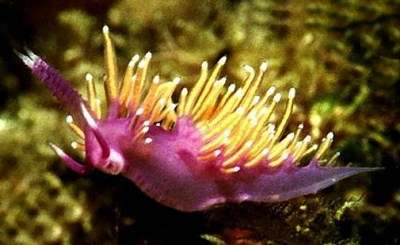
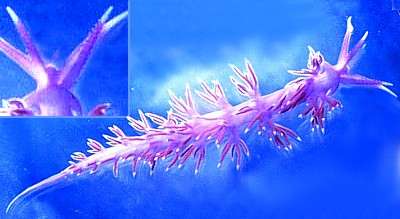
Flabellina ischitana
Hirano & Thompson, 1990
Order: NUDIBRANCHIA
Suborder: AEOLIDINA
Family: Flabellinidae
DISTRIBUTION
Mediterranean
PHOTO
UPPER: Lighthouse Reef, Qawra, Malta, 25m, May 1996. PHOTO: Erwin Koehler.
LOWER: Bay of Algeciras (Strait of Gibraltar, southern Spain) at 5m depth on Eudendrium racemosum,May, 1997. PHOTO: Cesar Megina.
'The general body color, including the rhinophores, oral tentacles, and ceratal bases is violet, though the apical region of oral tentacles and rhinophores is opaque white. The branches of the digestive gland can be seen through the skin of the ceras. Their color is orange to orange-red. The subapical zone of the cerata has an opaque white ring that partially obscures the cnidosacs, while the apex is hyaline white'... Cervera, Lopez-Gonzalez & Garcia-Gomez, 1998.
A very similarly coloured species, Flabellina affinis, has long been confused with Flabellina ischitana. The differences between the two were enumerated by Hirano & Thompson (1990) and more recently Cervera, Lopez-Gonzalez & Garcia-Gomez (1998). Essentially in Flabellina ischitana the ceratal surface is translucent, without violet colouration, while in Flabellina affinis the zone under the subapical white ring is opaque violet, obscuring the digestive gland.
See Erwin's message, and further photos at Erwin Koehler's list of opisthobranchs on the Web at http://www.medslugs.de/Opi/Opisthobranchia.htm
See Lucas Cervera's message below suggesting that Erwin Koehler's photo above is possibly an unnamed species, rather than F. ischitana.
Reference:
• Hirano, Y.J. & Thompson, T.E. (1990). Flabellinid nudibranchs from the Bay of Naples, with a description of a new species, Flabellina ischitana. Journal of Molluscan Studies, 56: 345-354
Rudman, W.B., 1999 (June 19) Flabellina ischitana Hirano & Thompson, 1990. [In] Sea Slug Forum. Australian Museum, Sydney. Available from http://www.seaslugforum.net/find/flabisch
Related messages
Flabellina ischitana laying eggs
July 30, 2008
From: Dominique Horst
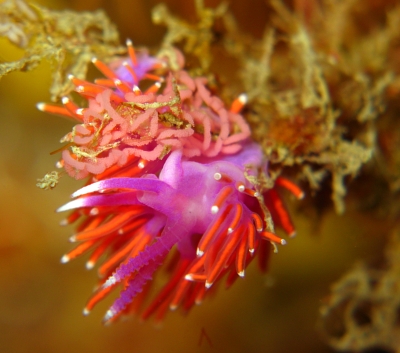
Hello Bill,
This is the first time I can get a shot showing Flabellina ischitana laying eggs.
Locality: Antibes, 15 m, France, Mediterranean sea, 19 April 2008. Length: 20 mm. Photographer: Dominique Horst.
Kind regards,
Dom.
dominique.horst@wanadoo.fr
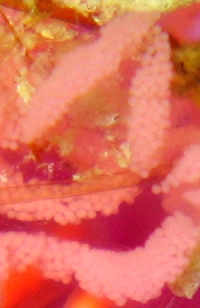
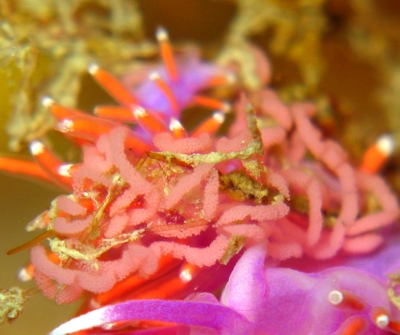
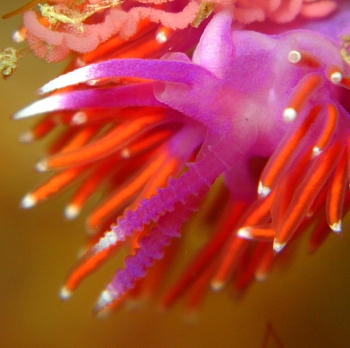
Thanks Dom,
I've included a few close-ups, including the one alongside which shows one of the main characters distinguishing this species from F. affinis. Essentially in Flabellina ischitana the ceratal surface is translucent, without violet colouration, while in Flabellina affinis the zone under the subapical white ring is opaque violet, obscuring the digestive gland.
Best wishes,
Bill Rudman
Flabellina ischitana from French Mediterranean
April 16, 2008
From: François Zylberman
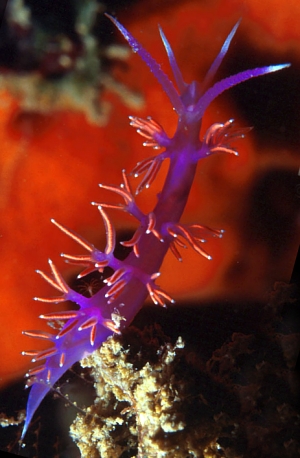
Dear Bill,
I send you the photo of an aerolid which I can't ID. It is taken in French mediterranean coast.
Locality: Lerins islands, France, Mediterranean Sea, 1998. Photographer: François Zylberman.
Thank you for your help.
François Zylberman
www.geodia.com
francois@geodia.com
Zylberman, F., 2008 (Apr 16) Flabellina ischitana from French Mediterranean. [Message in] Sea Slug Forum. Australian Museum, Sydney. Available from http://www.seaslugforum.net/find/20871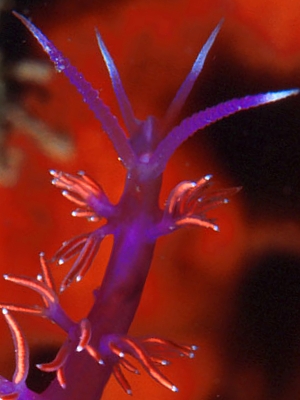
Dear François,
I am pretty sure this is Flabellina ischitana. Another species which is of similar colour and has the cerata arranged on a common stalk like this is F. affinis. However in that species there is an opaque purple band around the cerata, just below the white tip, which can't be seen in your photo.
Best wishes,
Bill Rudman
Flabellina ischitana also at lunch time
June 13, 2007
From: Dominique Horst
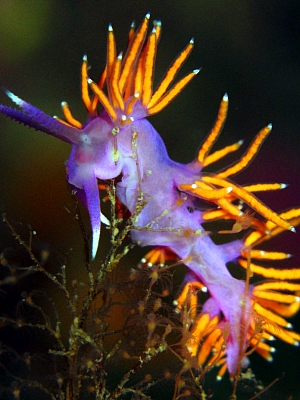
Hi Bill,
As I now know how to capture aeolids at lunch, here's lunch time for Flabellina ischitana. Just for fun...
Locality: Cap d'Antibes, 10 m, France, Mediterranean sea, 16 January 2007, vertical rock. Length: 20 mm. Photographer: Dominique Horst.
Kind regards,
Dominique
dominique.horst@wanadoo.fr
Horst, D., 2007 (Jun 13) Flabellina ischitana also at lunch time. [Message in] Sea Slug Forum. Australian Museum, Sydney. Available from http://www.seaslugforum.net/find/19249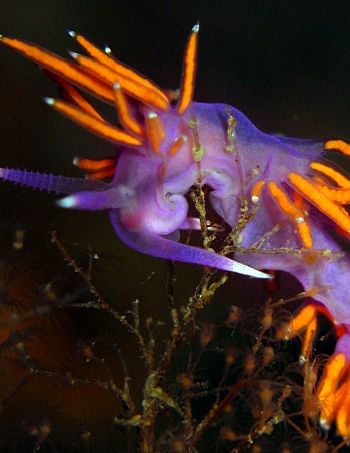
Thanks Dom,
Best wishes,
Bill Rudman
Could F. ischitana eat C. peregrina eggs ?
June 13, 2007
From: Dominique Horst
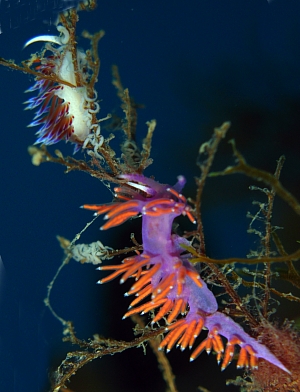
On this occasion Flabellina ischitana seemed to be attracted to the Cratena peregrina eggs. Unfortunately I could not stay long enough to see what happened. Could F. ischitana eat C. peregrina eggs ? Is it something that is currently observed between aeolids species ?
Locality: Cap d'Antibes, 10m, France, Mediterranean sea, 16 January 2007, vertical rock. Length: 20mm. Photographer: Dominique Horst.
Many thanks for your help
Kind regards,
Dominique
dominique.horst@wanadoo.fr
Horst, D., 2007 (Jun 13) Could F. ischitana eat C. peregrina eggs ?. [Message in] Sea Slug Forum. Australian Museum, Sydney. Available from http://www.seaslugforum.net/find/19250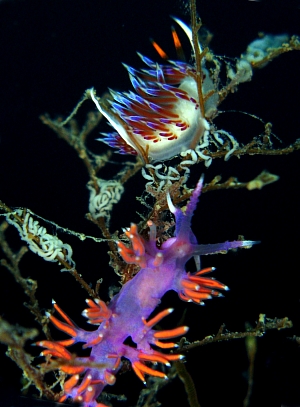
Dear Dom,
Species of Flabellina are thought to normally feed on hydroids. However if you look at any aeolids of the genus Favorinus on the Forum, you will see that they specialise on eating eggs of other opisthobranchs.
I would guess in this case the Flabellina was just climbing the hydroid in its daily search for food.
Best wishes,
Bill Rudman
Flabellina from Turkey
January 2, 2005
From: Elif Özgür
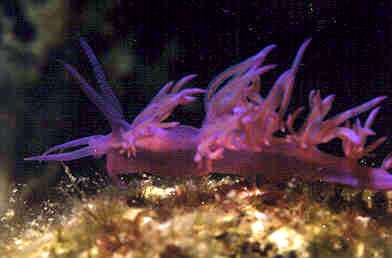
Dear Bill
Are all of these specimens in the photos Flabellina affinis or is it too hard to distinguish these species?
They are all from Turkey, Mediterranean Sea. [Photos: Ferda Büyükbaykal]
Elif Özgür
eozgur@istanbul.edu.tr
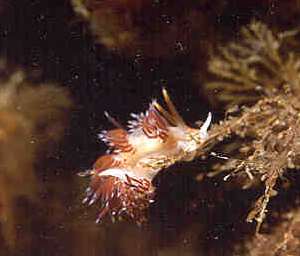
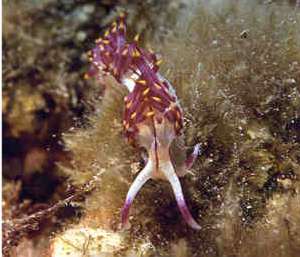
Dear Elif,
Your photos are all of aeolid nudibranchs but they are three different species. Most aeolid species can be identified externally if we can see the colour and shape of the live animal, details of the the rhinophores and shape and arrangement of the cerata, and details of the head and foot. If there is doubt we would need to look at the internal anatomy to be sure, which is a bit beyond what we can do on the Forum. But in most cases, species can be identified from good photos. I would need larger scans than the ones you sent this time. I would also need to have some more information on the location the animal was found. I also need to know, if the photographer is not you, who the photographer is and whether you have permission to send the photo to the Forum.
In this message the upper right photo is probably Flabellina affinis but could be Flabellina ischitana. The lower left photo is probably Cratena peregrina, but it would be useful to see a photo which showed the head more clearly, so that I could see if the orange spots this species usually has on the head are there. The lower right photo is almost certainly Flabellina rubrolineata, which you will see from earlier messages on the Forum is a Red Sea species which has entered the Mediterranean via the Suez Canal.
If you have better scans you would like me to check, could you send each species as a separate message and include more details on where and when the species was photographed
Best wishes,
Bill Rudman
Flabellina ischitana from the Adriatic Sea
December 30, 2004
From: Luigi Montevecchi
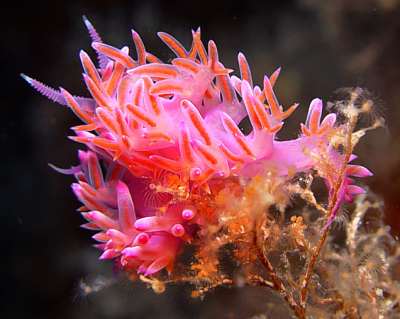
Hi Bill!
This picture, taken with a digital camera (Sony F-717), seems to display two individuals of Flabellina affinis coupling one above another: What do you think?
Locality: Caprara - Tremiti Islands. Italy, Adriatic Sea
Depth: 10 meters, Length: 12-14 mm, 17 August 2004
Rocks, with a sandy bottom at about 20 meters
Photographer: Luigi Montevecchi
Luigi Montevecchi
montevecchi@iol.it
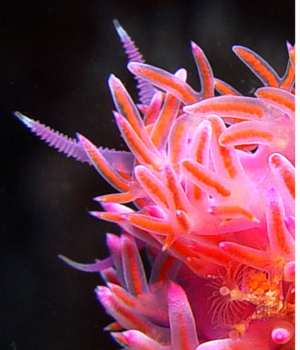
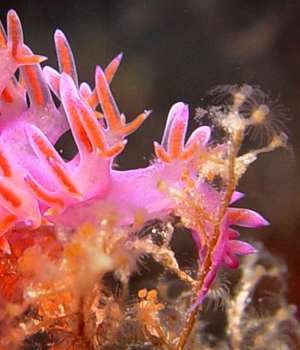
Dear Luigi,
Thanks for the photo. Firstly I think this is probably Flabellina ischitana rather than Flabellina affinis. Have a look at my reply to an earlier message [#5566] of Baki Yokes on these two species for further information. Basically the ceratal wall in F. affinis is an opaque purple colour while in P. ischitana it is transparent, and the digestive gland duct can be clearly seen.
I'm afraid I can't see any evidence that the two are mating, but it is a fairly normal occurrence when two animals are close together like this. I have added a couple of close-ups of your photo to show the lamellae on the rhinophores [lower left] and how each cluster of cerata are arranged on a common stalk [lower right]. In the right foreground of the lower right photo are some expanded hydroid polyps. no doubt the food of this species.
Best wishes,
Bill Rudman
Flabellina ischitana? from French Mediterranean
June 29, 2002
From: Marina Poddubetskaia
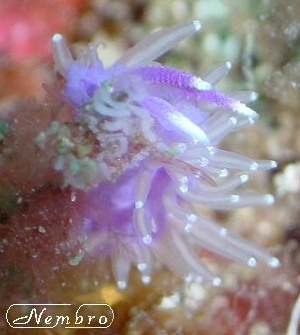
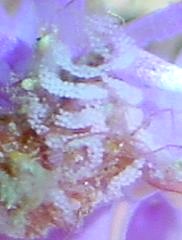
Dear Bill,
Could you help me to identify this Flabellina, please.
Date: June 04, 2002
Location: Cap Croisette (near Marseille), France
Site: Pierre qui tramole
Depth: 14m
Size: less than 1cm
+ a close-up of egg-mass (in the foreground on the photo).
Best wishes,
Marina.
marina.poddubetskaia@orange-sc.com
Poddubetskaia, M., 2002 (Jun 29) Flabellina ischitana? from French Mediterranean. [Message in] Sea Slug Forum. Australian Museum, Sydney. Available from http://www.seaslugforum.net/find/7344Dear Marina,
I am pretty sure that this is Flabellina ischitana. It is very similar externally to Flabellina affinis but differs in having transparent or translucent ceratal walls, which allow the digestive gland ducts to be seen quite clearly, as in your photo. The ducts are usually coloured red, orange or yellow. I guess this juvenile hasn't accumulated enough of the right coloured pigment from its food as yet.
Best wishes,
Bill Rudman
Re: Flabellina pedata and others? from Turkey (2)
October 28, 2001
From: Juan Lucas Cervera
Dear Bill,
I agree with you this species is Flabellina ischitana.
Lucas.
lucas.cervera@uca.es
Cervera, J.L., 2001 (Oct 28) Re: Flabellina pedata and others? from Turkey (2). [Message in] Sea Slug Forum. Australian Museum, Sydney. Available from http://www.seaslugforum.net/find/5579Thanks Lucas,
Bill Rudman
Re: Flabellina pedata and others? from Turkey (3)
October 28, 2001
From: Juan Lucas Cervera
Dear Bill,
I consider that this animal is also Flabellina ischitana. The intensity of the violet color in F. affinis and F. ischitana is variable. Even in F. ischitana the number of rhinophoral lamellae can be variable. I've seen some specimens with almost smooth rhinophores. The color white in these can be more or less conspicuous also.
Cheers.
Lucas.
lucas.cervera@uca.es
Cervera, J.L., 2001 (Oct 28) Re: Flabellina pedata and others? from Turkey (3). [Message in] Sea Slug Forum. Australian Museum, Sydney. Available from http://www.seaslugforum.net/find/5580Thanks Lucas,
It is certainly simpler if this is F. ischitana as well.
Bill Rudman
Flabellina pedata and others? from Turkey (2)
October 27, 2001
From: Baki Yokes
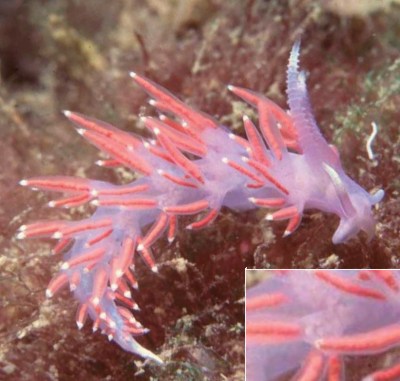
Hi Bill,
Here are some more Flabellina photos.
UPPER RIGHT: Canakkale, Turkey. July 1999.
Divesite: Saros Bay, Depth: 15m, Size: 35mm
LOWER LEFT: Gökova, Turkey. August 1999.
Divesite: Yediadalar, Depth: 10m, Size: 30mm
LOWER RIGHT: Istanbul, Turkey. 7 October, 2001.
Divesite: Yassiada, Depth: 28m, Size: 30mm
Best regards
Baki
bakiyokes@turk.net
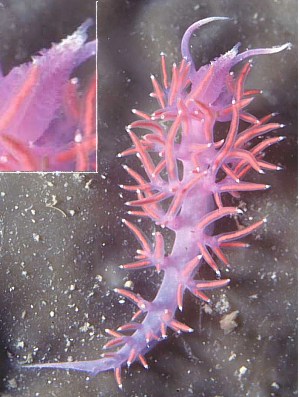
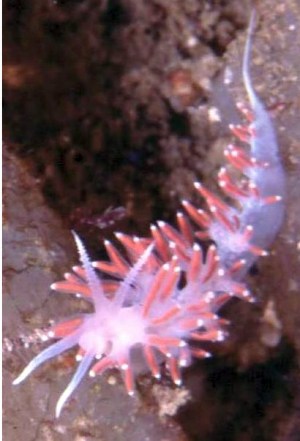
Dear Baki,
I think these are all Flabellina ischitana which is easy to confuse with Flabellina affinis unless the internal anatomy is examined. Both have lamellate rhinophores and the ceratal clusters have common bases. One of the main external differences is that in F. ischitana the ceratal wall is transparent allowing the digestive gland to be seen. In F. affinis the ceratal wall is dusted with purple, obscuring the digestive gland. Using that criteria, this would be F. ischitana. In the upper right photo I have included an inset to show the whitish gonad tissue in the base of the ceratal clusters.
Two other characters which Hirano & Thompson (1990) noted are that in F. ischitana there are between 12-19 rhinophoral lamellae, while in F. affinis there are 22-28. They also distinguish the two species on the number of branches to the main basal trunk of the first ceratal cluster - 3 branches in F. ischitana and 4 in F. affinis. From your photos I think your animals match F. ischitana.
I would be grateful for any comments from people familiar with these two species. [See also message 1 and message 3 with photos of similarly coloured animals]
Best wishes,
Bill Rudman
Flabellina pedata and others? from Turkey (3)
October 27, 2001
From: Baki Yokes
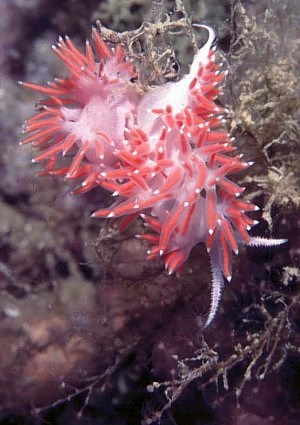
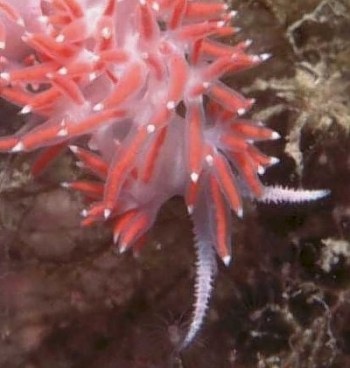
Dear Bill,
Here is another Flabellina pedata-looking animal.
Data: Çanakkale, Turkey. June 1999
Divesite: Saros Bay, Depth: 15m, Size: 35mm
PHOTOS: Baki Yokes
Best regards
Baki
bakiyokes@turk.net
Yokes, B., 2001 (Oct 27) Flabellina pedata and others? from Turkey (3). [Message in] Sea Slug Forum. Australian Museum, Sydney. Available from http://www.seaslugforum.net/find/5567Dear Baki,
I suspect this is Flabellina ischitana, like the other photos, but there are some differences. This one also has lamellate rhinophores, but they seem to be more numerous like in F. affinis. However the rhinophores are white with no purple. In fact there is no sign of purple anywhere. The ceratal wall is transparent, like F. ischitana, but I am not sure.
I would be grateful for some thoughts from some of you more familar with the Mediterranean fauna. [See also Baki's message with photos of Flabellina pedata]
Best wishes,
Bill Rudman
Re: Flabellina ischitana from nthn Spain
March 23, 2001
From: Juan Lucas Cervera
Dear Bill,
I agree with Bernard Picton's identification.
Cheers,
Lucas.
lucas.cervera@uca.es
Cervera, J.L., 2001 (Mar 23) Re: Flabellina ischitana from nthn Spain. [Message in] Sea Slug Forum. Australian Museum, Sydney. Available from http://www.seaslugforum.net/find/4014Thanks Lucas,
Bill Rudman
Flabellina ischitana from nthn Spain
March 19, 2001
From: Bernard Picton
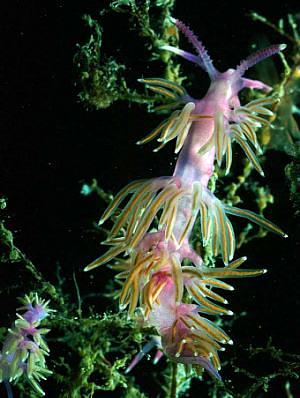
Hi Bill,
I was just looking through a few pictures I have of Mediterranean nudibranchs and I found this one which I had labelled as Flabellina affinis. There are two animals, an adult and a juvenile on a Eudendrium sp. hydroid. On looking at the Forum I see that it fits exactly Lucas Cervera's
definition of Flabellina ischitana. I've enclosed a big scan so you can cut bits out of it, in particular the contrast between the violet body colour and the transparent surface to the cerata shows well in this photo. If the digestive gland coloration is as variable as it is in some other Flabellina species then Erwin's photo may well be F. ischitana.
Medas Is, NE Spain - May 1987
Bernard
bernard.picton.um@nics.gov.uk
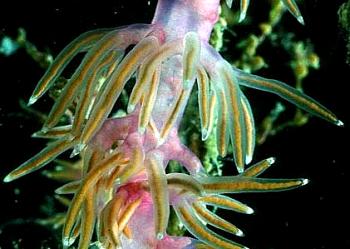
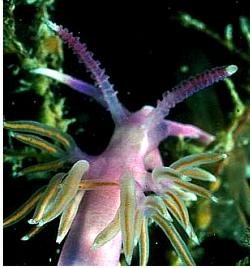
Thanks Bernard,
Bill Rudman
Re: Flabellina ischitana
July 9, 1999
From: Juan Lucas Cervera
Dear Bill:
I'm absolutely in agreement of your comments to Erwin. My comments are not a criticism! I only wished to claim the possibility of an overlooked undescribed violet Flabellina in the Mediterranean. In fact, very recently, two other violet species of this genus has been described by Ortea & Espinosa (1998) from Cape Vert Islands (Eastern Atlantic), F. arveloi and F. alternata, and are different from the F. affinis from Ghana.
Two good photographs of F. affinis and F. ischitana appear in the "Atlas of Mediterranean Nudibranchs", and that of F. ischitana seems to me different from Erwin's. In this book, when you read "the colour of the cerata is red", this refers to the colour of the digestive gland; and when you read "the tips of the cerata are white", this refers to the subapical opaque white band (ring) at the upper part of the cerata. The true tips are translucent whitish that allow us to see the cnidosacs, also whitish.
In my opinion, it would be interesting to check specimens with colouration like those of Erwin's photographs. Only to be sure.
The Daniel L. Geiger's photos of F. affinis are very good and permit to identify well the species externally.
Regards,
Lucas.
PS. It was Cesar Megina and not me who taken the Flabellina ischitana photo.
Lucas.
lucas.cervera@uca.es
Cervera, J.L., 1999 (Jul 9) Re: Flabellina ischitana. [Message in] Sea Slug Forum. Australian Museum, Sydney. Available from http://www.seaslugforum.net/find/1039Re: Flabellina ischitana
July 8, 1999
From: Erwin Koehler
Concerning Lucas Cervera's comments about my identification of Flabellina ischitana.
I started 2 years ago with the Mediterranean Slug Site with the intention to show other divers and interested people how beautiful these small critters are. There were several slugs I couldn't identify. Helmut Debelius gave me the hint: Atlas of Mediterranean Nudibranchs.
This book was my first scientific one on sea slugs. The description of Flabellina ischitana in this book is:
"There are 6-9 clusters of cerata on each side of the back. Each cluster has 3 to 6 cerata, all inserted on a common stalk. The general body colour is purple, darker than in Flabellina affinis. Rhinopores and cerata present white tips. The colour of the cerata is red."
According to this description I identified them as F. ischitana.
Recently Heike Waegele sent a paper to me which compares F. affinis with the other Med. Flabellina species. Summary: "F. ischitana can be distinguished from F. affinis by its more uniform colour, the shape of the masticatory processes and the presence of a proximal receptaculum". - Nothing a diver can see.
Erwin
Medslugs.Koehler@t-online.de
Koehler, M., 1999 (Jul 8) Re: Flabellina ischitana. [Message in] Sea Slug Forum. Australian Museum, Sydney. Available from http://www.seaslugforum.net/find/1030Dear Erwin,
Lucas's comment about your identification was not a criticism of your efforts, which are much appreciated by all of us. Your Meditteranean Slug Site and the many messages you have sent to the Forum are greatly valued.
On the available published information, your animal seems to fit Flabellina ischitana and I would probably identify it as such. Basically, from his experience with Flabellina ischitana and Flabellina affinis, Lucas has a 'hunch' that your animal may in fact be another as yet unrecognised species and he would love to look at some specimens to see if there are any different anatomical characters, that we can't see in a photo or from the outside of the living animal.
If we consider how long Flabellina ischitana was considered a form of Flabellina affinis, it wouldn't be a great surprise if there was another similarly looking species still deceiving us.
We still have a lot to learn about nudibranchs. Books are a great help but they are only as good as the author and the information available to the author at the time the book was published. In this case, if there is a third species we don't know about at present, its characters will be mixed with one of the other species and confusing the existing descriptions.
One purpose of the Sea Slug Forum is to give everyone an opportunity to discuss identification problems and keep us all up to date with current thinking. Hopefully your picture, and Lucas's comments, will inspire someone to collect some specimens that match the animal in your photos and either have a look at their anatomy or send them to Lucas who I am sure would love to be able to compare them with 'typical' Flabellina ischitana.
Best wishes,
Bill Rudman
Flabellina ischitana
July 7, 1999
From: Juan Lucas Cervera

Hi Bill!
Finally I have got to scan the Flabellina ischitana slide, I mentioned in my earlier message.
The animal was collected in May, 1997 at the Bay of Algeciras (Strait of Gibraltar, southern Spain) at 5m depth on Eudendrium racemosum.
More information about this species in:
1998. J.L. Cervera, P.J. Lopez Gonzalez & J.C. Garcia Gomez. Redescription of the aeolid nudibranch Flabellina ischitana Hirano & Thompson, 1990 Gastropoda: Opisthobranchia). The Veliger, 41(3): 289-293.
Cheers.
Lucas.
lucas.cervera@uca.es
Cervera, J.L., 1999 (Jul 7) Flabellina ischitana. [Message in] Sea Slug Forum. Australian Museum, Sydney. Available from http://www.seaslugforum.net/find/1023Dear Lucas,
Thanks for the picture. I have prepared a page on Flabellina affinis for comparison. It certainly would be interesting to check the anatomy of the animals that Erwin Koehler photographed.
Bill Rudman.
Flabellina ischitana
June 19, 1999
From: Juan Lucas Cervera
Dear Bill:
I'm not convinced that the picture of the animal that E. Koehler attributes to Flabellina ischitana belongs truly to that species. Hirano & Thompson (1990) supplied a color plate of their species. I have collected it in southern Iberian peninsula (many specimens). Their color is in agreement with those of Naples (type locality) and most of the internal anatomy. Probably, many records of F. affinis in the Mediterranean should be attributed to F. ischitana. I have published a redescription of this species in THE VELIGER (July 1998: J.L. Cervera & P.J. Lopez-Gonzalez) in which are detailed the extenal and internal anatomy and are compared with those of F. affinis. Neither species have yellow marks.
It would be very interesting to study the specimen/s photographed by E. Koehler.
Juan Lucas Cervera
lucas.cervera@uca.es
Dear Lucas,
Have you have a 'typical' photo of Flabellina ischitana I could put on the Forum? I have a photo from Daniel Geiger of what I think is Flabellina affinis so it would be good to have the three on the Forum so that they could be compared with each other.
Best wishes,
Bill Rudman.
Re: Mystery from Holland
June 5, 1999
From: Erwin Koehler

Dear Bill,
Attached is Flabellina ischitana Hirano & Thompson, 1990 - maybe this is Xavier's mystery from Holland? ...
Erwin
Medslugs.Koehler@t-online.de
Koehler, E., 1999 (Jun 5) Re: Mystery from Holland. [Message in] Sea Slug Forum. Australian Museum, Sydney. Available from http://www.seaslugforum.net/find/922Thanks Erwin,
We'll see what Xavier thinks?
Bill Rudman.
